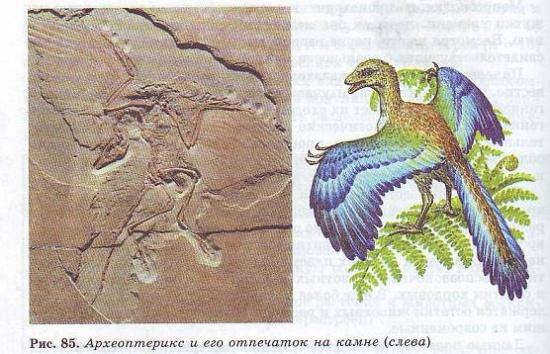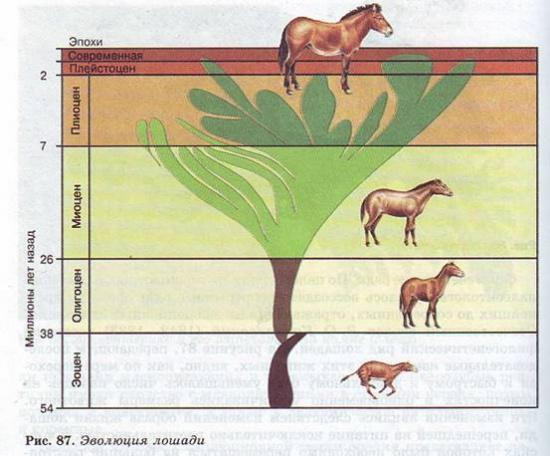39. Macroevolution, its evidence.
Macroevolution, its evidence
1. What facts can indicate the connection between extinct and modern plants and animals? 2. What types of ancient plants and animals do you know?
Process education from species of new genera, from genera - new families, and so on are called macroevolution. Macroevolution is a supraspecific evolution, in contrast to microevolution that occurs within a species, within it populations ... However, there are no fundamental differences between these processes, since macroevolutionary processes are based on microevolutionary ones.In macroevolution, the same factors act - the struggle for existence, natural selection and associated extinction. Macroevolution, like microevolution, is divergent in nature.
Macroevolution occurs at historically grandiose intervals of time, so it is not directly studyable. Despite this, the science has a lot of evidence, testifying to the reality of macroevolutionary processes.
Paleontological evidence for macroevolution. You already know that paleontology studies the fossil remains of extinct organisms and establishes their similarities and differences with modern organisms.
Paleontological data make it possible to learn about the flora and fauna of the past, to reconstruct the external fraction of extinct organisms, to discover the connection between the most ancient and modern representatives of flora and fauna.
Convincing evidence of changes in the organic world over time is provided by a comparison of fossil remains from the earth's strata of different geological eras. It allows you to establish the sequence of the emergence and development of different groups. organisms ... So, for example, in the most ancient layers, the remains of representatives of types of invertebrates are found, and in later layers, the remains of chordates are found. Even younger geological strata contain the remains of animals and plants belonging to species similar to modern ones.
Paleontological data provide a lot of material about the successive relationships between various taxonomic groups. In some cases, it was possible to establish transitional forms between the most ancient and modern groups of organisms, in others - to reconstruct phylogenetic series, that is, the series of species successively replacing one another.
Fossil transitional forms.
On the banks of the Northern Dvina, a group of animal-toothed reptiles was found (Fig. 84). They combined the features of mammals and reptiles ... Animal-toothed reptiles are similar to mammals in the structure of the skull, spine and limbs, as well as in the division of teeth into canines, incisors and molars.

The find of Archeopteryx is of great interest from an evolutionary point of view (Fig. 85). This animal the size of a dove had the characteristics of a bird, but still retained the features of reptiles. Bird signs: hind limbs with tarsus, presence of feathers, general appearance. Reptile signs include a long row of caudal vertebrae, abdominal ribs, and the presence of teeth. Archeopteryx could not be a good flyer, since his sternum (without the keel), pectoral muscles and wing muscles are poorly developed. The spine and ribs were not a rigid skeletal system, stable in flight, as in modern birds. Archeopteryx can be considered a transitional form between reptiles and birds. Transitional forms combine the features of both ancient and more evolutionarily young groups at the same time. Another example is ichthyosteg, a transitional form between freshwater cross-finned fishes and amphibians (Fig. 86).

Phylogenetic series.
For a number of groups of animals and plants, paleontologists have managed to recreate continuous series of forms from ancient to modern, reflecting their evolutionary changes. Domestic zoologist V.O.Kovalevsky (1842-1883) recreated the phylogenetic series of horses. Figure 87, which conveys the successive changes in these animals, shows how, as the transition to fast and long running, the number of fingers on the limbs decreased and at the same time the size of the animal increased. These changes were the result of changes in the lifestyle of the horse, which switched to feeding exclusively on vegetation, in search of which it was necessary to travel long distances. It is believed that all these evolutionary transformations took 60-70 million years.
Embryological evidence for macroevolution.
Convincing evidence of the degree of kinship between organisms is provided by embryology, which studies the embryonic development of organisms. Charles Darwin noted the existence of interrelationships between the individual development of an organism (ontogeny) and their evolutionary development (phylogeny). These connections have been studied in detail by subsequent researchers.
The vast majority of organisms develop from a fertilized egg. Let us trace the successive stages of development of embryos of fish, lizard, rabbit, and man. A surprising similarity concerns the shape of the body, the presence of a tail, primordia of limbs, gill pockets on the sides of the pharynx (see Fig. 71). In many respects, the internal organization of the embryos is also similar at these early stages. All first have a notochord, then a spine of cartilaginous vertebrae, a circulatory system with one circle of blood circulation (like in fish), the same structure of the kidneys, etc.
As development progresses, the similarity between embryos weakens, the features of those classes to which they belong become more and more clearly manifested. Gill pockets grow overgrown in lizards, rabbits, and humans; in the human embryo, the head section, including the brain, develops especially strongly, five-fingered limbs are formed, and in fish embryos, fins. In the course of embryonic development, there is a successive divergence of the characters of the embryos, acquiring features that characterize the class, order, genus, and, finally, the species to which they belong.
The stated facts indicate the origin of all chordates from one "trunk", which in the course of evolution disintegrated into many "branches"

Other evidence.
From the biology courses in grades 7-8, you know about the general plan of the structure of vertebrates. The overwhelming majority of organisms are characterized by a cellular structure. The principles of cell division are the same in all eukaryotes. The implementation of genetic coding, biosynthesis of proteins and nucleic acids also occurs according to the same mechanism for all life on Earth. All these facts indisputably testify to a single plan for the structure and common origin of all organisms.







